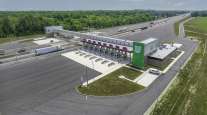Senior Reporter
Toll Charges Continue to Have an Impact on Trucking’s Bottom Line, Says ATRI Study

[Stay on top of transportation news: Get TTNews in your inbox.]
Toll charges have increased significantly over the past decade, and continue to have a major impact on trucking financial results, according to a new study by American Transportation Research Institute.
The study found that toll revenues increased 72.5% over 10 years, with $14.7 billion in revenue collected in 2018.
“For comparison, the percentage increase in the Consumer Price Index for the same time period was 16.9%,” ATRI said.
ATRI Financial Analysis of ... by Transport Topics on Scribd
ATRI used data from 21 toll systems representing some 81% of all U.S. tolling revenues.
The study showed that commercial vehicle toll costs were the second-highest trucking industry cost per mile metric behind driver pay.
“Toll costs for commercial vehicles were 45 cents per mile, which exceeds every cost-per-mile metric from ATRI’s 2018 operational cost survey with the exception of driver wages which were 59.6 cents per mile,” according to the ATRI study released Jan. 29.

Hawkins
This is in “stark contrast” to the 14.6 cents per mile paid by trucks for federal and state transportation-related taxes and fees, it added.
ATRI said that in addition to paying $4.2 billion in tolls across the 21 toll systems, trucks paid $811 million annually in federal and state taxes while traveling across the study sample’s toll facilities.
“It is clear from this research that highway funding mechanisms that return our tax investments to highways are far superior to tolling,” said Darren Hawkins, CEO of YRC Worldwide. “We need greater oversight and transparency to ensure that the billions of dollars paid by our industry goes back into the roads and bridges that generate the revenue.”
Some of the study’s other findings:
- Toll facilities are, on average, three times more costly than traditional funding, and typically the toll fee is collected on top of the traditional taxes contributed by the trucking industry.
- Nearly half (48.2%) of the $4.2 billion tolls paid by the trucking industry in 2018 were diverted from the direct costs associated with providing use of the toll facilities. “Thus it could be surmised that the trucking industry is overpaying for toll services by at least $2 billion every year at the selected locations,” the study said.
- Through traditional taxes and fees, the industry is estimated to pay 14.6 cents per mile in exchange for the use of public roadways. To drive 100 miles at this rate would cost $14.60.
- Tolls remain an ineffective means of funding highways. Previous research into tolling found large inefficiencies in collection costs when compared to fuel taxes. For instance, while some toll authorities in the early 2000s were dedicating 21.9% to 30.3% of revenue to toll administrative collections, the cost to states for administering a fuel tax was 1% to 2% and administering the federal fuels tax was only 0.2%.
Based on available information, the study also found that commercial vehicles generated more than one-third of a billion transactions (377.5 million) in 2018 at 19 out of the 21 locations.
New #ATRI Research Documents Who Pays and Who Benefits From Toll System Revenue https://t.co/NpUUV2DjVi #Trucking #TruckResearch — Rebecca Brewster (@ATRIPREZ) January 29, 2020
The average paid per transaction was $10.22.
For light-duty vehicles, more than 5.1 billion transactions occurred, based on the review of 2018 Comprehensive Annual Financial Reports, with an average paid per transaction of $1.84. Thus, commercial vehicles pay approximately 550% more per transaction than light-duty vehicles.
In part one of a two-part exploration of autonomous technology today, our latest RoadSigns podcast revisits conversations with CEOs Alex Rodrigues of Embark and Cetin Mericli of Locomation. Hear them explain what testing automated trucks and developing platooning technology has taught them about the road ahead — and get new perspective with host commentary. Listen to a snippet from Rodrigues above, and to hear the full episode, go to RoadSigns.TTNews.com.
The study said the Pennsylvania Turnpike offers a brief case study for why the trucking industry has growing concerns over tolls. In 2019 it was reported that the Pennsylvania Turnpike Commission had approved a 6% toll rate increase to keep pace with rising debt-service costs, increasing the cost to travel the east-west length of the turnpike to $422 per trip ($293 for E-ZPass) for a truck.
“Though the Pennsylvania Turnpike situation is arguably unfair to trucking, such examples have not deterred states from pursuing toll revenue from the trucking industry,” ATRI said.
In 2016, Rhode Island legislators made the unprecedented move of introducing a trucks-only tolling program on interstate highways. The state claimed that “the RhodeWorks bridge tolling program is a unique approach to repairing bridges by tolling only specific types of tractor-trailers,” and that “the tolls collected at each location in Rhode Island will go to repair the bridge or bridge group associated with that toll location.”
In a lawsuit filed in 2018, however, plaintiffs including American Trucking Associations argued that this program violates the Commerce Clause of the U.S. Constitution because it discriminates against out-of-state or interstate trucking entities and does not reflect a fair user fee to those who pay the toll.
“As these examples and others illustrate, trucking is often a target revenue source for those states that need money to close funding gaps,” the study said. “This is often an easy political decision since truck tolls are charged to businesses, not individuals or voters. Likewise, trucks often have no choice but to pay a toll due to lack of alternative routes.”
Want more news? Listen to today's daily briefing:




